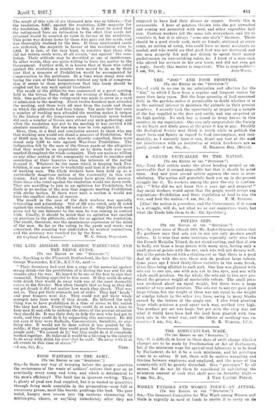POTATO SETS.
[To THE EDITOR OF THE " SPECTATOR."I
SIR,—In your issue of March 24th Mr. Loder-Symonds writes that lihs gardener says that sets cut to one eye only produce small tubers. It is true that some varieties, especially early ones like the French Marjolin Tetard, do not stand cutting, and that if sets be badly cut from a large potato with many eyes, having only a small piece of potato with the eye, such sets will not do very well. But if the potato be cut with a slanting cut so that there is a good deal of skin with the eye, these sets do produce large tubers. Some years ago I tried thirty-three varieties in the same break, three lines being allotted to each sort. One line was planted with sets cut to one eye, one with sets cut to two eyes, and one with whole small potatoes. On the whole, the sets cut to two eyes pro- duced the greatest weight of marketable tubers. The small pota- toes produced about an equal weight, but there were a large number of very small potatoes. The sets cut to one eye gave good large tubers, but the weight of these was not equal to the weight of similar tubers in the other two lines, owing to many blanks caused by the failure of the single eye. I also tried planting large whole potatoes a yard apart each way, earthed very high. Ihe produce per set was large, but per acre the crop was HOE what it would have been had the land been planted with two- eyed sets in the usual way, and the labour of earthing` was exe


























 Previous page
Previous page